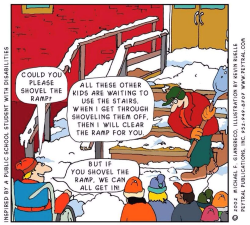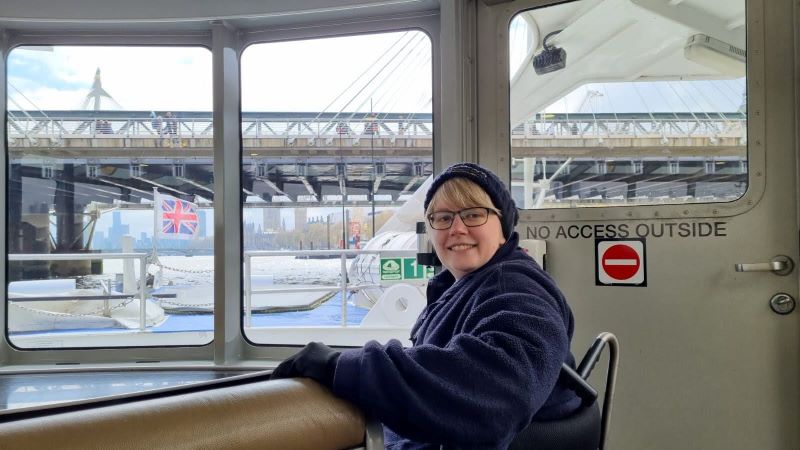Jenny Wheeler is CAE’s newest team member having joined in September 2023. Before she came to CAE she helped improve accessibility at the University of Warwick through various roles since 2014, but most recently as their in-house Accessibility Officer. She is an active member of the Access Association and the National Register of

Jenny Wheeler, Access Advisor
Access Consultants (NRAC). Read on to find out more about Jenny, including why she pursued NRAC accreditation, and if she believes inclusiveness and accessibility are improving for disabled people now Covid regulations have been removed.
How do you define inclusive design and accessibility?
One of my favourite illustrations of an inclusive environment is a cartoon depicting snow covered steps and ramp at a school.
The caretaker is shovelling the snow off the steps and the kids are waiting at the bottom to get in. There is a student in a wheelchair waiting too who asks, “Could you please shovel the ramp?”. The caretaker replies “All these other kids are waiting to use the stairs. When I get through shovelling them off, then I will clear the ramp for you.”

The student in the wheelchair replies “But if you shovel the ramp, we can all get in!”. An inclusive environment recognises that improved accessibility benefits everyone.
Why did you decide to specialise in inclusive design/access?
When I was a chemistry student, I discovered my disability (despite its genetic element) and became a wheelchair user during my first year.
Suddenly I encountered a new world and the true meaning of the Social Model of Disability whereby someone is disabled by their environment. I set about trying to improve the built environment around me and along the way found that this was a real profession.
Shortly after graduating in 2017, I took my first courses with CAE, joined the Access Association and NRAC as a Supporter and found a whole community of like-minded people with the same aspirations as me.
What do you see as the biggest issue hurdle facing disabled and older people in society today?
Attitudes of people with decision-making powers. In my experience, if you have someone who has the power to make decisions who is on board and doesn’t see inclusive environment principles as a tick box exercise, that can make all the difference.
Is inclusiveness and accessibility still improving for disabled people or are things going backwards now Covid regulations have been removed?
Whilst big progress has been made, particularly in remote working opportunities which can benefit many, there are times where I have seen that it is possible to do something a different way because we all did it over lockdown.
But now, for a disabled person to ask for the same thing as an adjustment, it’s somehow an unreasonable request again. This can be frustrating as a disabled person.
What do you see as the biggest hurdle facing disabled people in the built environment in the next 5-10 years?
We only need to look at the news and we see proposed changes which could have a massive impact on disabled people, for example the closure of railway ticket offices.
Personally, I feel the biggest hurdle will be where changes are made that have the legal “due regard” to the impact on disabled people and other protected characteristics, but plough ahead with plans anyway with minimal meaningful mitigation in place.
Going back to the Social Model of Disability whereby someone is disabled by their environment, there are worrying signs that the environment may become more disabling and people who have had the freedom and independence to go about their lives now will have additional barriers, which did not exist before.
Why did you pursue NRAC accreditation?
I was accredited as an NRAC Access Consultant in December 2021. I wanted to assess my knowledge and experience against the respected industry standards and benchmark that comes with the accreditation process.
I was also keen to receive feedback on my work. As a single person accessibility team in my previous role, I didn’t have the opportunity to bounce ideas off others or gain feedback on my work other than through events with the Access Association and NRAC. It was also important for me to go through the peer review process.
Can you explain the process for you to become an accredited NRAC Consultant?
I had joined NRAC as a Supporter member in 2017 and went to the annual conferences. Someone recommended the Towards Membership course, which I really enjoyed as it was my first opportunity to get feedback on my knowledge and experience and gave me the confidence that I was ready to go through the process.
I submitted my Stage 1 application around October 2019, meaning that my Stage 2 needed to be submitted around April 2020. We all know what happened in March 2020… For me though, this gave me an interesting opportunity to experiment with an alternative audit style.
I was at home and gave a colleague who was on site my 360 camera and we did a virtual audit whereby I could see everything they were doing, could give instructions like “measure this” and could control the 360 camera, which took pictures of the whole environment.
I could then interact with the environment live, but then review things afterwards using the 360 photos we had taken either by manipulating them on screen or with a VR headset.
As a disabled access professional, I wanted to test out alternative ways that I could audit places that I couldn’t get to myself (the irony of the job sometimes). Due to further lockdown restrictions, we only completed half the building in this way and when I was finally able to visit site, I completed the audit of the other half myself in person, but still took 360 photos for the report.
It was interesting to compare the two methods and there were definitely pros and cons to both. I did find the 360 photos useful though as you can always guarantee there’s something you forget to photograph on an audit or that’s just out of shot. Not with this one.
I was nervous for the interview itself, but they put you at ease. Having been on the Towards Membership course I felt more prepared as I had been given a flavour of some of the questions that might come up and could fill some of the gaps in my knowledge accordingly.
What does the accreditation mean to you personally and for your career?
It was great to get feedback on my knowledge and experience and it felt for the first time like I was a real access professional, not just a chemistry graduate who ditched chemistry! It gave me the confidence to pursue roles outside the position I had and ultimately brought me to CAE.
Since joining NRAC I also joined their Advisory Group so can now influence the organisation and use my experience to give back.
Would you recommend it for others considering a career in inclusive design and access?
I would definitely recommend pursuing the accreditation. I would also recommend the Towards Membership sessions. The peer review and feedback parts were invaluable, particularly as a lonely access professional in my previous organisation.
If you could make or change one law today regarding inclusive design and accessibility, what would it be?
To make inclusive design and accessibility the norm and not the exception or luxury add on. If the building regulations were broader in their inclusive environment principles other than just disability and made other improvements to match BS 8300 then it wouldn’t be as hard to push for best practice when people are looking at the “bare minimums” they can get away with.
It is also frustrating sometimes when Part M isn’t treated in the same regard as other Approved Documents such as Part B or Part K.
Can you name one CAE project that you feel has made a significant impact in terms of inclusion and access?
I’ve been following the work that CAE has been doing with the Pathways Academy and I am really impressed with the initiative. I think it’s really important to inspire and give opportunities to the next generation of access professionals.

